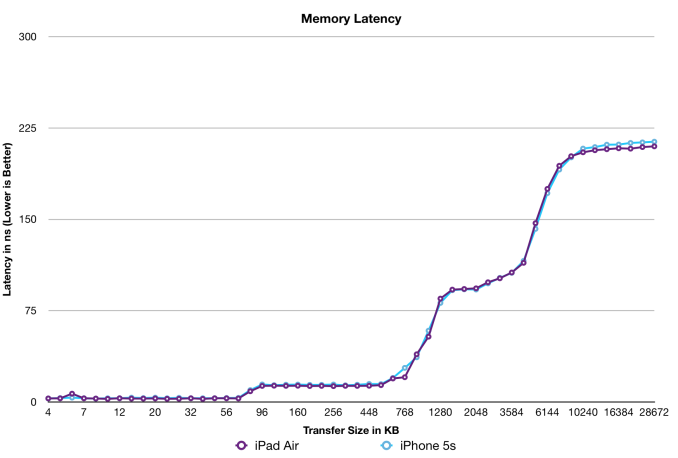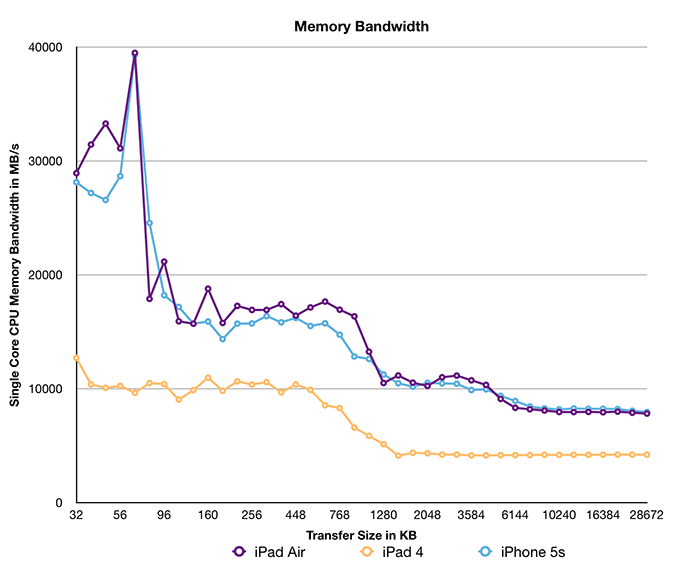The iPad Air Review
by Anand Lal Shimpi on October 29, 2013 9:00 PM ESTAn Update on Apple’s A7: It's Better Than I Thought
When I reviewed the iPhone 5s I didn’t have much time to go in and do the sort of in-depth investigation into Cyclone (Apple’s 64-bit custom ARMv8 core) as I did with Swift (Apple’s custom ARMv7 core from A6) the year before. I had heard rumors that Cyclone was substantially wider than its predecessor but I didn’t really have any proof other than hearsay so I left it out of the article. Instead I surmised in the 5s review that the A7 was likely an evolved Swift core rather than a brand new design, after all - what sense would it make to design a new CPU core and then do it all over again for the next one? It turns out I was quite wrong.
Armed with a bit of custom code and a bunch of low level tests I think I have a far better idea of what Apple’s A7 and Cyclone cores look like now than I did a month ago. I’m still toying with the idea of doing a much deeper investigation into A7, but I wanted to share some of my findings here.
The first task is to understand the width of the machine. With Swift I got lucky in that Apple had left a bunch of public LLVM documentation uncensored, referring to Swift’s 3-wide design. It turns out that although the design might be capable of decoding, issuing and retiring up to three instructions per clock, in most cases it behaved like a 2-wide machine. Mix FP and integer code and you’re looking at a machine that’s more like 1.5 instructions wide. Obviously Swift did very well in the market and its competitors at the time, including Qualcomm’s Krait 300, were similarly capable.
With Cyclone Apple is in a completely different league. As far as I can tell, peak issue width of Cyclone is 6 instructions. That’s at least 2x the width of Swift and Krait, and at best more than 3x the width depending on instruction mix. Limitations on co-issuing FP and integer math have also been lifted as you can run up to four integer adds and two FP adds in parallel. You can also perform up to two loads or stores per clock.
I don’t yet have a good understanding of the number of execution ports and how they’re mapped, but Cyclone appears to be the widest ARM architecture we’ve ever seen at this point. I’m talking wider than Qualcomm’s Krait 400 and even ARM’s Cortex A15.
I did have some low level analysis in the 5s review, where I pointed out the significantly reduced memory latency and increased bandwidth to the A7. It turns out that I was missing a big part of the story back then as well…
A Large System Wide Cache
In our iPhone 5s review I pointed out that the A7 now featured more computational GPU power than the 4th generation iPad. For a device running at 1/8 the resolution of the iPad, the A7’s GPU either meant that Apple had an application that needed tons of GPU performance or it planned on using the A7 in other, higher resolution devices. I speculated it would be the latter, and it turns out that’s indeed the case. For the first time since the iPad 2, Apple once again shares common silicon between the iPhone 5s, iPad Air and iPad mini with Retina Display.
As Brian found out in his investigation after the iPad event last week all three devices use the exact same silicon with the exact same internal model number: S5L8960X. There are no extra cores, no change in GPU configuration and the biggest one: no increase in memory bandwidth.
Previously both the A5X and A6X featured a 128-bit wide memory interface, with half of it seemingly reserved for GPU use exclusively. The non-X parts by comparison only had a 64-bit wide memory interface. The assumption was that a move to such a high resolution display demanded a substantial increase in memory bandwidth. With the A7, Apple takes a step back in memory interface width - so is it enough to hamper the performance of the iPad Air with its 2048 x 1536 display?
The numbers alone tell us the answer is no. In all available graphics benchmarks the iPad Air delivers better performance at its native resolution than the outgoing 4th generation iPad (as you'll soon see). Now many of these benchmarks are bound more by GPU compute rather than memory bandwidth, a side effect of the relative lack of memory bandwidth on modern day mobile platforms. Across the board though I couldn’t find a situation where anything was smoother on the iPad 4 than the iPad Air.
There’s another part of this story. Something I missed in my original A7 analysis. When Chipworks posted a shot of the A7 die many of you correctly identified what appeared to be a 4MB SRAM on the die itself. It's highlighted on the right in the floorplan diagram below:

A7 Floorplan, Courtesy Chipworks
While I originally assumed that this SRAM might be reserved for use by the ISP, it turns out that it can do a lot more than that. If we look at memory latency (from the perspective of a single CPU core) vs. transfer size on A7 we notice a very interesting phenomenon between 1MB and 4MB:
That SRAM is indeed some sort of a cache before you get to main memory. It’s not the fastest thing in the world, but it’s appreciably quicker than going all the way out to main memory. Available bandwidth is also pretty good:
We’re only looking at bandwidth seen by a single CPU core, but even then we’re talking about 10GB/s. Lookups in this third level cache don’t happen in parallel with main memory requests, so the impact on worst case memory latency is additive unfortunately (a tradeoff of speed vs. power).
I don’t yet have the tools needed to measure the impact of this on-die memory on GPU accesses, but in the worst case scenario it’ll help free up more of the memory interface for use by the GPU. It’s more likely that some graphics requests are cached here as well, with intelligent allocation of bandwidth depending on what type of application you’re running.
That’s the other aspect of what makes A7 so very interesting. This is the first Apple SoC that’s able to deliver good amounts of memory bandwidth to all consumers. A single CPU core can use up 8GB/s of bandwidth. I’m still vetting other SoCs, but so far I haven’t come across anyone in the ARM camp that can compete with what Apple has built here. Only Intel is competitive.












444 Comments
View All Comments
dishayu - Wednesday, October 30, 2013 - link
I agree on one tiny point with you. The shortcomings of a device need to be highlighted when it comes out... NOT when the successor is launched. And I've read AnandTech long enough to know that this is not just a problem with Apple reviews. This is the problem with all reviews... Android, PC and storage reviews and so on... As soon as a refresh/next gen product is launched, the previous gen suddenly develops issues/shortcomings. Don't get me wrong, their reviews are still the best and more in-depth than rest of the internet combined, but they seriously need to address this little issue.BlakKW - Wednesday, October 30, 2013 - link
pretty valid observationerrorr - Wednesday, October 30, 2013 - link
I'm not sure people really understand the shortcomings when a product comes out. I appreciate when Anand or Brian use a product for a while and their insights are far superior, but initial impressions on a review are still subject to change gradually.KoolAidMan1 - Wednesday, October 30, 2013 - link
How dare a company improve the performance of its productsandroticus - Tuesday, October 29, 2013 - link
When is that MacBook Pro review coming???? :)FwFred - Wednesday, October 30, 2013 - link
Yep, much more excited about that from a device standpoint, though the A7 investigaton was interesting.tipoo - Tuesday, October 29, 2013 - link
Woah, the Surface charges fast.MarcSP - Tuesday, October 29, 2013 - link
Yeah. Ii is not just a little bit, it is half the time! Of course the review somehow tries not to make it look as a really negative thing or at least something to really improve for the next iPad. In fact it says it is GOOD, compared to ipad 3 and 4, that were ludicrously slow in charging.Of course, in the Surface 2 review there was no mention at all of this fast charging, only of the "average battery life".
And BTW I think battery life in Surface 2 should be retested. It is extremely weird that it got less web browsing time than Surface 1 (and that this discrepancy was not even mentioned in the review). If possible use a different Surface 2 device, just in case it had some problem.
YuLeven - Wednesday, October 30, 2013 - link
And other sites got 14 hours of battery when testing the Surface 2.basroil - Tuesday, October 29, 2013 - link
" The iPad Air crashed a couple of times on me (3 times total during the past week), but no where near as much as earlier devices running iOS 7.0.1. "Not a single W8 device I own has ever crashed from system memory issues (one crashes because the GPU was overclocked too hard and graphics memory suffered from it, but that's hardware failure not software)